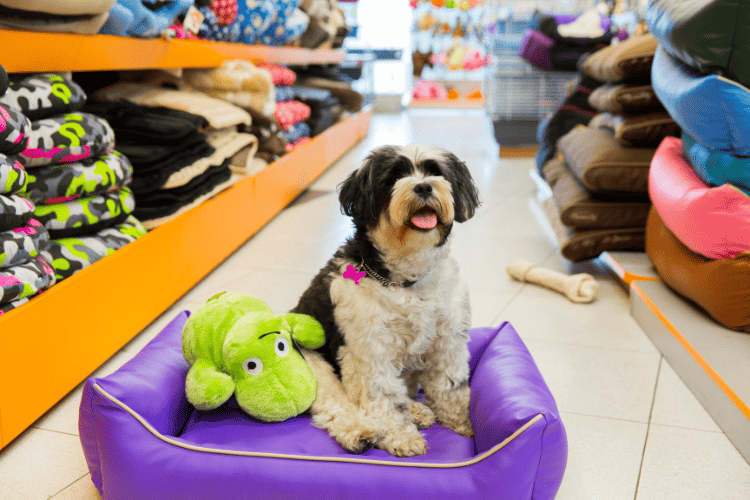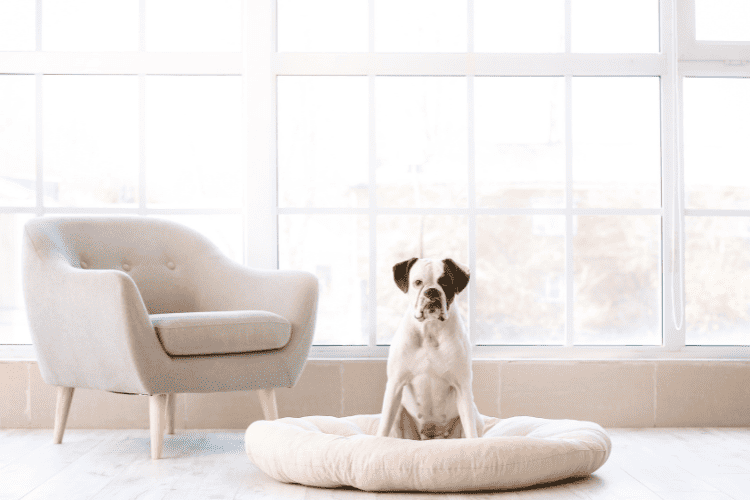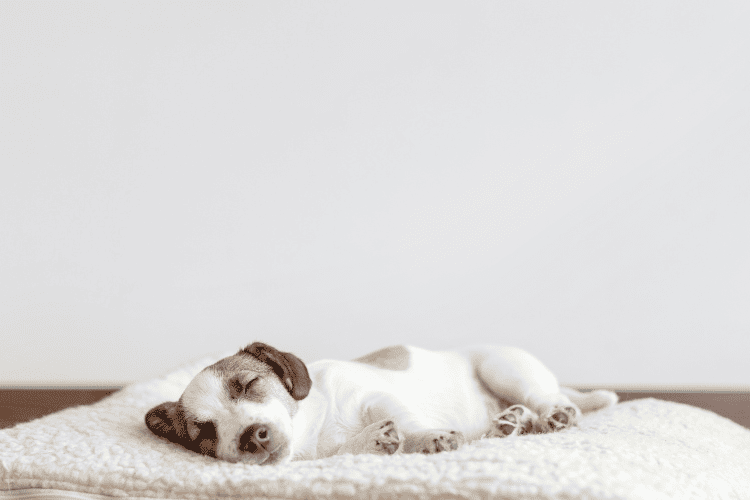Choosing the perfect dog bed is an important decision. Dogs spend a significant amount of time resting and sleeping, so providing them with a comfortable and supportive bed is essential. In this comprehensive guide, we’ll cover various factors to consider when choosing a bed for your furry friend.
Size and Shape:
Selecting the right size bed is crucial to ensure your dog has enough space to stretch out comfortably. Consider your dog’s current size and any potential growth if they are still a puppy. The bed should be large enough for your dog to lie down in their favourite sleeping position. Additionally, consider the shape of the bed, such as rectangular, round, or bolstered, based on your dog’s preferences.
Sleeping Style:

Observe your dog’s sleeping habits. Some dogs enjoy curling up, while others sprawl out. Certain beds, like doughnuts or nest beds, provide a cosy space for dogs who prefer curling up, while flat mattresses or orthopaedic beds are better for dogs that stretch out.
Age and Health Bed for Dogs Considerations:
Consider your dog’s age, health, and any specific needs they may have. For example, older dogs or those with joint issues may benefit from orthopaedic beds that provide extra support and relieve pressure points. Waterproof or easily washable beds are ideal for puppies or dogs prone to accidents.
Material and Durability:
Look for beds made from durable materials that can withstand your dog’s chewing, scratching, and nesting behaviours. Common bed materials include foam, memory foam, polyester fibre, and high-quality fabrics. Ensure that the bed’s cover is removable and machine washable for easy cleaning.
Climate and Temperature Consideration Bed for Dogs:

Consider your climate when choosing a bed. If you live in a colder region, heated beds or beds with extra insulation can keep your dog warm. In warmer climates, look for beds with breathable materials to prevent overheating. Additionally, elevated or raised beds can provide better airflow and help regulate temperature.
Safety and Allergies:
Ensure that the bed materials are safe for your dog and free from toxic substances. Avoid beds with small parts or loose filling that can be a choking hazard. If your dog has allergies, opt for hypoallergenic beds made from natural and non-irritating materials.
Ease of Cleaning and Maintenance:
Consider the ease of cleaning and maintaining the bed. Look for machine-washable beds or those with removable covers that can be easily cleaned. Beds with waterproof liners or stain-resistant materials can also be beneficial.
Price and Budget:
Set a budget for your dog’s bed and compare options within your price range. While quality and durability are important, you can find beds that suit your budget without compromising your dog’s comfort and safety.
User Reviews and Recommendations Bed for dogs:
Read reviews from other dog owners to gather insights into different bed brands and models. Recommendations from trusted sources such as friends, veterinarians, or pet experts can also help in making an informed decision.
Consider Your Dog’s Preferences:

Ultimately, consider your dog’s personal preferences. Some dogs may have specific likes or dislikes when it comes to beds. If possible, bring your dog to a pet store and let them try out different beds to see which one they prefer.
Choosing the Perfect Material for Your Dogs Bed

Choosing the right material for your dog bed is crucial for providing comfort, durability, and ease of maintenance. Here are some common materials used in dog beds and their characteristics:
Foam Bed for Dogs:
Foam is a popular material used in dog beds. It provides excellent support, conforms to the dog’s body, and relieves pressure points. Memory foam is especially beneficial for older dogs or those with joint issues. It offers superior comfort and can help alleviate discomfort.
Polyester Fiber Fill Beds:

The polyester fibre fill is a soft and lightweight material commonly used for stuffing in dog beds. It offers moderate support and creates a plush sleeping surface. This material is often used in pillow-like beds or beds with bolsters.
Cedar Chips Bed for Dogs:
Some dog beds are filled with cedar chips. Cedar has natural properties that repel pests like fleas and ticks, keeping your dog’s sleeping area fresh and free from unwanted visitors. Cedar also has a pleasant odour that can help control odours.
Cotton or Canvas Bed for Dogs:

Cotton or canvas materials are breathable, comfortable, and durable. They are easy to clean and maintain, making them a popular choice for dog beds. These materials are suitable for dogs who don’t have allergies or sensitivities.
Waterproof Materials Beds:
Waterproof materials, such as nylon or polyester with waterproof coatings, are useful for dogs that may have accidents or are prone to spilling water. These materials prevent liquids from seeping into the bed, protecting the inner filling and making clean-up easier.
Microfiber Bed for Dogs:
Microfiber is a synthetic material that is durable, soft, and stain-resistant. It is easy to clean and maintain, making it suitable for dogs who tend to bring dirt or mud into their beds. Microfiber is also resistant to odours and allergens.
The Importance of Providing a Quality Bed for Dogs

A quality dog bed plays a significant role in your pet’s overall well-being and comfort. Here are several reasons why providing a good dog bed is important:
Comfort and Support:
Just like humans, dogs need a comfortable place to rest and sleep. A good dog bed offers cushioning and support for your dog’s joints and muscles. It helps relieve pressure points, promotes better sleep, and improves overall comfort.
Joint Health and Pain Relief:
Dogs, especially older ones or those with arthritis or other joint conditions, can benefit greatly from a supportive bed. Orthopaedic dog beds, which are designed with memory foam or supportive padding, provide excellent joint support and can help alleviate pain and discomfort.
Temperature Regulation:
Dog beds can help regulate your pet’s body temperature. Elevated beds allow air to circulate underneath, keeping your dog cool in hot weather. On the other hand, beds with insulating materials or self-warming properties provide warmth during colder seasons, ensuring your dog stays cosy and comfortable.
Protection and Security:

Having a designated bed gives your dog a sense of security and their own personal space. It creates a safe and familiar spot where they can relax, retreat, and feel protected. This is particularly important for dogs that may feel anxious or stressed in unfamiliar surroundings.
Hygiene and Cleanliness:
A good dog bed helps maintain cleanliness and hygiene in your home. By providing your dog with its own bed, you prevent them from sleeping on furniture or your own bed, reducing the transfer of dirt, fur, and potential allergens. Additionally, many dog beds come with removable and washable covers, making it easier to keep them clean and fresh.
Durability and Longevity:
Investing in a quality dog bed means you’re choosing a durable and long-lasting product. A well-made bed can withstand your dog’s activities, such as scratching or nesting, and maintain its shape and support over time. It saves you money in the long run by avoiding the need for frequent replacements.
Promotes Healthy Behavior:
Providing a comfortable and dedicated space for your dog encourages them to rest and sleep in their own area. This can help prevent them from seeking out alternative, less desirable sleeping spots, such as your furniture or personal belongings.
Choosing the perfect bed for your dog is an important decision that can greatly impact their comfort, health, and overall well-being. By considering factors such as size, sleeping style, material, durability, climate suitability, and your dog’s specific needs and preferences, you can select a bed that provides optimal comfort, support, and hygiene. A quality dog bed promotes healthy sleep, helps alleviate joint pain, regulates temperature, and creates a secure and personal space for your furry friend. Investing in a good dog bed is an investment in your dog’s happiness and ensures they have a cosy and relaxing place to rest for years to come.


